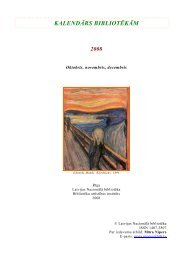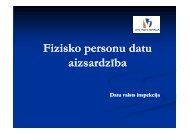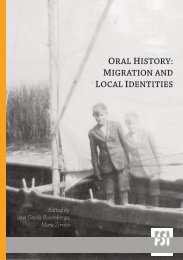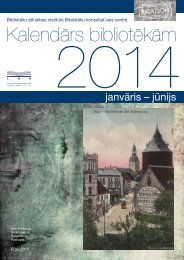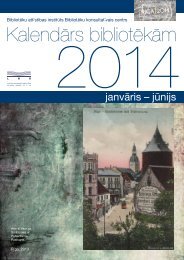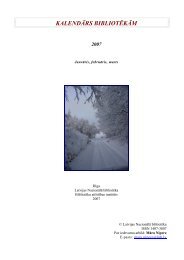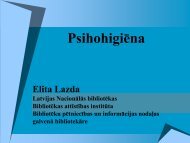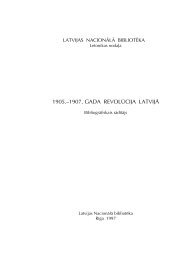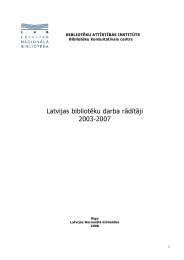representation of the countryside and agriculture as values - Academia
representation of the countryside and agriculture as values - Academia
representation of the countryside and agriculture as values - Academia
- No tags were found...
Create successful ePaper yourself
Turn your PDF publications into a flip-book with our unique Google optimized e-Paper software.
LATVIJAS SOCIĀLĀ ATMIŅA UN IDENTITĀTEMANUSKRIPTISOCIAL MEMORY OF LATVIA AND IDENTITYWORKING PAPERSKlinta LočmeleREPRESENTATION OF THECOUNTRYSIDE ANDAGRICULTURE AS VALUESIN THE LATVIAN NATIONAL IDENTITY IN THE DAILY“LATVIJAS AVĪZE” (2004–2008)ISSN 1691-90172011. 4. LAIDIENS / VOLUME 4
Klinta LočmeleREPRESENTATION OF THE COUNTRYSIDE ANDAGRICULTURE AS VALUES IN THE LATVIAN NATIONALIDENTITYin <strong>the</strong> daily “Latvij<strong>as</strong> Avīze” (2004–2008)Paper h<strong>as</strong> been presented in <strong>the</strong> conference “Lithuanian euro‐integration, nationalidentity, <strong>and</strong> collective historical memory” (Vilnius, November 20–21, 2009) <strong>and</strong>published <strong>as</strong>: Ločmelė, Klinta. Kaimo ir žemės ūkio kaip latvių taunės tapatybėsvertybių vaizdavim<strong>as</strong> dienraštyje LATVIJAS AVĪZE (2004–2008). In: Gaižutytė‐Filipavičienė, Ž., Rubavičius, V. (eds). Nacionalinis tapatum<strong>as</strong> medijų kultūroje (NationalIdentity in <strong>the</strong> Media Culture). Vilnius: Lietuvos kultūros tyrimų instut<strong>as</strong>, 2011.P. 223–234. (ISBN 978‐609‐427‐062‐8)
LATVIJAS SOCIĀLĀ ATMIŅA UN IDENTITĀTEMANUSKRIPTI. 2011. 4. LAIDIENSSOCIAL MEMORY OF LATVIA AND IDENTITYWORKING PAPERS. 2011. VOLUME 4ISSN 1691-9017Laur<strong>as</strong> Āboliņ<strong>as</strong> un Mārtiņa Z<strong>and</strong>berga vāka dizainsCover design by Laura Āboliņa <strong>and</strong> Mārtiņš Z<strong>and</strong>bergsCountryside <strong>and</strong> <strong>agriculture</strong> historically have been seen <strong>as</strong> one <strong>of</strong> <strong>the</strong> strongest pillars <strong>of</strong>Latvian national identity. Since <strong>the</strong> first national awakening in <strong>the</strong> middle <strong>of</strong> 19thcentury in culture <strong>and</strong> ideology, Latvians have positioned <strong>the</strong>mselves <strong>as</strong> farmers,particularly during <strong>the</strong> first Republic <strong>of</strong> Latvia (1918–1940). Viewpoint about Latvians <strong>as</strong>ploughman nation revived again after <strong>the</strong> dissolution <strong>of</strong> USSR <strong>and</strong> retrieval <strong>of</strong> l<strong>and</strong>edproperty. Latvia experienced a rapid incre<strong>as</strong>e <strong>of</strong> <strong>the</strong> number <strong>of</strong> farms.Now Latvia is a part <strong>of</strong> Europe’s present‐day political, economic <strong>and</strong> cultural system <strong>of</strong><strong>values</strong>. Social, economic <strong>and</strong> political circumstances have determined changes in <strong>the</strong>prestige <strong>of</strong> <strong>the</strong> <strong>countryside</strong> <strong>and</strong> <strong>agriculture</strong>. Analysis <strong>of</strong> <strong>the</strong> newspaper “Latvij<strong>as</strong> Avīze”content shows that today <strong>the</strong> <strong>countryside</strong> <strong>and</strong> <strong>agriculture</strong> are at a crossroads when itcomes to <strong>the</strong>ir meaning, future <strong>and</strong> value. It means, that <strong>the</strong> b<strong>as</strong>ic elements <strong>of</strong> Latvianidentity, probably is starting to fall to pieces.Key words: national identity, <strong>countryside</strong>, <strong>agriculture</strong>, <strong>representation</strong>, <strong>values</strong>, “Latvij<strong>as</strong>Avīze”© Klinta Ločmele, 2011© Laura Āboliņa, Mārtiņš Zanbergs, vāka dizains, 20112
ContentDiscourse <strong>of</strong> <strong>agriculture</strong> 5Returning to p<strong>as</strong>t: initial hopes <strong>and</strong> collapse 6The newspaper “Latvij<strong>as</strong> Avīze” <strong>and</strong> methodology 8The main research results 10An <strong>agriculture</strong>: mission or business? 10Farmers <strong>and</strong> Latvians: common character 12Modernisation instead traditions 13The present roles <strong>of</strong> <strong>the</strong> <strong>countryside</strong> 14Conclusion 16Summary 18Bibliography 203
Paper is focused on analysis <strong>of</strong> <strong>the</strong> way in which <strong>the</strong>re is mediated<strong>representation</strong> <strong>of</strong> <strong>the</strong> <strong>values</strong> <strong>of</strong> <strong>the</strong> Latvian nation in terms <strong>of</strong> <strong>the</strong> <strong>countryside</strong> <strong>and</strong><strong>agriculture</strong>. Media <strong>representation</strong> <strong>of</strong> <strong>the</strong>se <strong>values</strong> provides evidence <strong>of</strong> shifts in nationalidentity.The <strong>countryside</strong> <strong>and</strong> <strong>agriculture</strong> have undeniably been <strong>of</strong> historical importancein <strong>the</strong> establishment <strong>and</strong> maintenance <strong>of</strong> <strong>the</strong> national identity <strong>of</strong> Latvians. Latvians havepositioned <strong>the</strong>mselves <strong>as</strong> farmers, <strong>and</strong> <strong>the</strong>y have seen <strong>the</strong> <strong>countryside</strong> <strong>as</strong> <strong>the</strong> main placewhere Latvianness, <strong>the</strong> stability <strong>of</strong> <strong>the</strong> nation <strong>and</strong> its traditions are preserved. Changesin <strong>the</strong> prestige <strong>of</strong> <strong>the</strong> <strong>countryside</strong> <strong>and</strong> <strong>agriculture</strong>, <strong>as</strong> well <strong>as</strong> in Latvia’s socioeconomic<strong>and</strong> political circumstances have also led to changes in <strong>the</strong> meaning, which is attachedto <strong>the</strong> <strong>countryside</strong> <strong>and</strong> <strong>agriculture</strong> in terms <strong>of</strong> <strong>the</strong> value system <strong>of</strong> <strong>the</strong> Latvian nationalidentity <strong>and</strong> its <strong>representation</strong> in <strong>the</strong> media. Here I specifically refer to <strong>the</strong>transformation <strong>of</strong> b<strong>as</strong>ic elements <strong>of</strong> national identity in <strong>the</strong> daily “Latvij<strong>as</strong> Avīze.” As <strong>the</strong>meanings have changed, national identity itself h<strong>as</strong> changed, <strong>as</strong> well.The aim <strong>of</strong> my research w<strong>as</strong> to look at <strong>the</strong> meaning, which “Latvij<strong>as</strong> Avīze”attached to <strong>the</strong> <strong>countryside</strong> <strong>and</strong> <strong>agriculture</strong> during <strong>the</strong> first five years after Latvia joined<strong>the</strong> European Union (2004–2008). I have looked at <strong>the</strong> issue <strong>of</strong> whe<strong>the</strong>r <strong>the</strong> way inwhich <strong>the</strong> paper presents <strong>the</strong> <strong>countryside</strong> <strong>and</strong> <strong>agriculture</strong> represents <strong>values</strong> related to<strong>the</strong> Latvian national identity or whe<strong>the</strong>r <strong>the</strong>y are gradually being eliminated from those<strong>values</strong>.4
Discourse <strong>of</strong> <strong>agriculture</strong>In <strong>the</strong> middle <strong>of</strong> <strong>the</strong> 19 th century a part <strong>of</strong> Latvian nation representatives strivedto dispose <strong>of</strong> <strong>the</strong> unification <strong>of</strong> concepts “Latvian” <strong>and</strong> “farmer” due to serfdom madepoverty. But simultaneously, c<strong>of</strong>ormable to <strong>the</strong> ideologs’ viewpoint <strong>of</strong> discussed period,farmers’ emancipation also w<strong>as</strong> Latvians’ emancipation, who formed <strong>the</strong> b<strong>as</strong>e forequality <strong>and</strong> wholesomeness <strong>of</strong> Latvian nation (Plakans, 1974, 1981).After <strong>the</strong> establishment <strong>of</strong> independent state in 1918, Latvia w<strong>as</strong> rustled by“farming wave”. About agrarian reform that w<strong>as</strong> conducted in <strong>the</strong> first Republic <strong>of</strong>Latvia historian Katrina Z. S. Schwartz (2006, 8, 43) h<strong>as</strong> written that it w<strong>as</strong> done with <strong>the</strong>purpose <strong>of</strong> creating a nation <strong>of</strong> farmers – conservative <strong>and</strong> ethnical homogeneous.O<strong>the</strong>r historians, for example, Arnolds Aizsilnieks (1968, 233–257) also point out thatcreating wide farmers’ stratum w<strong>as</strong> guarantee for social stability <strong>and</strong> safety <strong>of</strong> newRepublic <strong>of</strong> Latvia – allocated plots developed citizens who were loyal to authority <strong>of</strong>Republic <strong>of</strong> Latvia. 1The discourse <strong>of</strong> <strong>agriculture</strong> w<strong>as</strong> praised in art <strong>and</strong> monuments. It w<strong>as</strong>particularly <strong>the</strong> authoritarian regime <strong>of</strong> President Kārlis Ulmanis, which supportedfarmers <strong>as</strong> <strong>the</strong> source <strong>of</strong> Latvian culture. Ulmanis himself embodied <strong>the</strong> image <strong>of</strong> aproper Latvian farmer <strong>as</strong> something, which would be understood in terms <strong>of</strong> <strong>the</strong>mentality <strong>of</strong> Latvians (Butulis, 1999, 7, 19). Also during <strong>the</strong> same period, <strong>the</strong> Latvianphilosopher Pauls Jurevičs (1936, 235–239) published a book in which he declared that“<strong>the</strong> Latvian nation can only be saved by our holding on to <strong>the</strong> <strong>countryside</strong>.” K. Schwartz(2006, 8) summarizes that <strong>the</strong> nature <strong>of</strong> <strong>the</strong> nation w<strong>as</strong> entwined with <strong>the</strong> <strong>values</strong> <strong>of</strong>farmers <strong>and</strong> <strong>the</strong>ir work.During <strong>the</strong> Soviet era, single‐family farms were closed down, <strong>and</strong> collectivisationw<strong>as</strong> organised. The “poesy <strong>of</strong> <strong>agriculture</strong>” began to be established in Latvian culture,particularly in <strong>the</strong> literature <strong>of</strong> <strong>the</strong> late 1960s <strong>and</strong> early 1970s (Hausmanis, 2001). Theidea <strong>of</strong> <strong>the</strong> close link between Latvianness <strong>and</strong> farming survived <strong>the</strong> 50 years <strong>of</strong> Sovietrule <strong>and</strong> w<strong>as</strong> also placed into <strong>the</strong> cradle <strong>of</strong> <strong>the</strong> restored Republic <strong>of</strong> Latvia.1 More about agrarian reform see also Bērziņš, V. (ed.). (2003). 20. gadsimta Latvij<strong>as</strong> vēsture. (Vol. 2,pp. 380–395). Rīga: Latvij<strong>as</strong> vēstures institūta apgāds.5
Returning to p<strong>as</strong>t: initial hopes <strong>and</strong> collapseDuring <strong>the</strong> post‐Soviet Latvian renaissance, historians supported <strong>the</strong> idea that<strong>the</strong>re should be just one historical narrative – that <strong>of</strong> continuity between <strong>the</strong> p<strong>as</strong>t (<strong>the</strong>first republic) <strong>and</strong> <strong>the</strong> restored Latvian state (Jubulis, 2007). Cultural sociologistDagmāra Beitnere (2003, 8) emph<strong>as</strong>izes that <strong>the</strong> agricultural achievements <strong>of</strong> <strong>the</strong> firstrepublic shaped memories <strong>of</strong> a farm <strong>as</strong> <strong>the</strong> symbol <strong>of</strong> welfare in <strong>the</strong> country – one,which included not just economic gains, but also national identity <strong>and</strong> Latvianness.That is why <strong>the</strong> equalisation <strong>of</strong> Latvianness <strong>and</strong> farming w<strong>as</strong> a typical element in<strong>the</strong> Latvian nation in <strong>the</strong> late 1980s <strong>and</strong> early 1990s. The words “resident <strong>of</strong> <strong>the</strong><strong>countryside</strong>” were seen <strong>as</strong> an equivalent <strong>of</strong> <strong>the</strong> word “Latvian”, notes historian VitaZelče (2006). The direct transfer <strong>of</strong> Latvian identity from <strong>the</strong> first republic to <strong>the</strong> years <strong>of</strong><strong>the</strong> national renaissance w<strong>as</strong> perhaps <strong>the</strong> e<strong>as</strong>iest way for <strong>the</strong> nation in <strong>the</strong> restoredstate to define itself <strong>and</strong> to decide on those <strong>values</strong>, which are <strong>of</strong> priority.The desire to have one’s own farm h<strong>as</strong> been <strong>of</strong> decisive importance in severaler<strong>as</strong> <strong>of</strong> <strong>the</strong> history <strong>of</strong> <strong>the</strong> Latvian people. That h<strong>as</strong> been true ever since <strong>the</strong> cancellation<strong>of</strong> indentured servitude in <strong>the</strong> 19 th century. In <strong>the</strong> early 1990s, many people in Latviamoved from cities to <strong>the</strong> <strong>countryside</strong> because <strong>the</strong>y obtained or regained ruralproperties.None<strong>the</strong>less, <strong>the</strong>re were circumstances which encouraged an audit <strong>of</strong> <strong>the</strong> <strong>values</strong><strong>of</strong> Latvian identity. These included an unstable national economy, <strong>the</strong> internationalmarket, <strong>and</strong> global processes in <strong>the</strong> world. The 10 to 20 years, which have p<strong>as</strong>sed since<strong>the</strong> restoration <strong>of</strong> independence, have not been enough for <strong>the</strong> stabilisation <strong>of</strong> a newfoundation for identity, although, on <strong>the</strong> o<strong>the</strong>r h<strong>and</strong>, it w<strong>as</strong> sufficient to make sure that<strong>the</strong> Latvian <strong>values</strong> that were communicated during <strong>the</strong> national renaissance faded, <strong>and</strong><strong>the</strong> Latvian identity took on a new appearance under <strong>the</strong> effects <strong>of</strong> <strong>the</strong> West <strong>and</strong> <strong>of</strong>globalisation.Researcher Dace Bula (2000, 53) writes that <strong>the</strong> renaissance restored <strong>the</strong> ability<strong>of</strong> Latvians for self‐<strong>representation</strong>, but this w<strong>as</strong> threatened by <strong>the</strong> country’s political <strong>and</strong>6
economic inclusion into <strong>the</strong> European Union in 2004, which opened <strong>the</strong> country up toalien cultures <strong>and</strong> lifestyles.The initial hope w<strong>as</strong> that <strong>the</strong> success <strong>of</strong> <strong>agriculture</strong> in <strong>the</strong> first republic would becontinued, but for complex re<strong>as</strong>ons, this led to a high level <strong>of</strong> unemployment in <strong>the</strong><strong>countryside</strong>, hopelessness, <strong>and</strong> an unwilling <strong>and</strong> slow departure from <strong>the</strong> dream <strong>of</strong>Latvia <strong>as</strong> a successful agrarian country. Instead <strong>the</strong>re were only a few major farms whichhad hopes for success, <strong>and</strong> <strong>the</strong>re w<strong>as</strong> never a proper answer to <strong>the</strong> question <strong>of</strong> whatwould happen to <strong>the</strong> Latvian <strong>countryside</strong> in future.Between <strong>the</strong> mid‐1990s <strong>and</strong> <strong>the</strong> beginning <strong>of</strong> <strong>the</strong> 21st century, <strong>the</strong>re were twocontradictory tendencies. On <strong>the</strong> one h<strong>and</strong>, statistics, <strong>as</strong> well <strong>as</strong> messages sent byindividual experts <strong>and</strong> representatives <strong>of</strong> <strong>the</strong> government, suggested that <strong>agriculture</strong> <strong>as</strong>a leading sector <strong>of</strong> <strong>the</strong> economy w<strong>as</strong> disappearing (<strong>and</strong> even that this should befacilitated <strong>as</strong> quickly <strong>as</strong> possible). By contr<strong>as</strong>t, <strong>the</strong>re were still public calls for argumentsthat would defend <strong>the</strong> idea that Latvians are a farming nation, along with <strong>the</strong> need topreserve <strong>agriculture</strong> <strong>as</strong> <strong>the</strong> cornerstone for <strong>the</strong> rural population. The idea that “Latvi<strong>as</strong>prings from <strong>the</strong> <strong>countryside</strong>”, however, began to fade.Ministry <strong>of</strong> Agriculture (2004, 7) saw <strong>agriculture</strong> exclusively <strong>as</strong> a manufacturingsector from which <strong>the</strong> highest level <strong>of</strong> effectiveness <strong>and</strong> a focus on sustainabledevelopment were expected. National policies were aimed at developing huge farms<strong>and</strong> country tourism, not at ensuring that traditional <strong>agriculture</strong> is seen <strong>as</strong> a priority. Thehistorian K. Schwartz (2006, 1, 84) notes: “As soon <strong>as</strong> Latvia began to integrate itself into<strong>the</strong> European <strong>and</strong> global market, <strong>the</strong> traditional balance between l<strong>and</strong>, work <strong>and</strong>Latvianness underwent a radical loss.”In this study my hope w<strong>as</strong> to see <strong>the</strong> way, in which “Latvij<strong>as</strong> Avīze” wrote about<strong>the</strong> <strong>countryside</strong> <strong>and</strong> <strong>agriculture</strong> at a time, when some rural residents were moving tocities or abroad, few farms were developing successfully <strong>and</strong> buying modern equipment,o<strong>the</strong>rs were unable to repay <strong>the</strong>ir loans, people were selling <strong>of</strong>f <strong>the</strong>ir farms, <strong>and</strong> <strong>the</strong><strong>countryside</strong> began to be a place where <strong>the</strong>re were depopulated farm villages, emptyfarms, <strong>and</strong> overgrown meadows.7
The newspaper “Latvij<strong>as</strong> Avīze” <strong>and</strong> methodology“Latvij<strong>as</strong> Avīze” is one <strong>of</strong> three national dailies to be published in <strong>the</strong> Latvianlanguage, <strong>and</strong> it h<strong>as</strong> positioned itself <strong>as</strong> a nationalist <strong>and</strong> conservative newspaper. It h<strong>as</strong>more subscribers than any o<strong>the</strong>r papers <strong>and</strong> it is one <strong>of</strong> <strong>the</strong> most widely read presspublications in <strong>the</strong> country. 2 Newspaper w<strong>as</strong> established in 1988, <strong>and</strong>, until 2003, it w<strong>as</strong>known <strong>as</strong> “Lauku Avīze” (“Countryside Newspaper”). During <strong>the</strong> renaissance, <strong>the</strong> paperwrote about rural residents <strong>and</strong> farming, presenting messages about Latvianness <strong>and</strong><strong>the</strong> traditional system <strong>of</strong> <strong>values</strong> which relates to it.Researcher Ilze Liepiņa (2004) writes that “Lauku Avīze” in <strong>the</strong> first years <strong>of</strong>21st century positioned itself <strong>as</strong> a defender <strong>of</strong> all farmers’ interests, but looks at <strong>the</strong>munified, marking <strong>the</strong>m <strong>as</strong> “<strong>agriculture</strong>” or “<strong>countryside</strong> <strong>of</strong> Latvia.” She notes thatconcept “farmer” becomes a sinekdoha, which in <strong>the</strong> newspaper marks wider entirety –“nation”, “Latvians.”This study is b<strong>as</strong>ed on content analysis <strong>and</strong> historical discourse analysis (aferresearcher Ruth Wodak). I analysed issues <strong>of</strong> “Latvij<strong>as</strong> Avīze” from August, September<strong>and</strong> October <strong>of</strong> each year from 2004 <strong>and</strong> 2008 – <strong>the</strong> first five years after Latvia’saccession to <strong>the</strong> European Union. Such selection <strong>of</strong> months is supported in practical<strong>as</strong>sumption that this period <strong>of</strong> year is <strong>the</strong> most intensive agrarian se<strong>as</strong>on <strong>and</strong>newspaper <strong>of</strong>fers more <strong>representation</strong> <strong>of</strong> it. Thereby analysis involved 15 months, 394issues <strong>and</strong> 421 publications (interviews, descriptive materials, discussions, photoreports, commentary <strong>and</strong> feuilletons).Selection <strong>of</strong> “Latvij<strong>as</strong> Avīze” covers representing <strong>countryside</strong> <strong>and</strong> <strong>agriculture</strong> seein Image 1.2 After market research company “TNS” data, in autumn 2008 „Latvij<strong>as</strong> Avīze” w<strong>as</strong> in <strong>the</strong> third place in <strong>the</strong>top <strong>of</strong> avarage audithory <strong>of</strong> one issue. Since winter 2005, it is an incre<strong>as</strong>e for two places. Look more at:Briča, L. (2008). Nacionālais mediju pētījums: Prese, V<strong>as</strong>ara 2008–Rudens 2008. TNS. Retrieved January26, 2009, from http://www.tns.lv/?lang=lv&fullarticle=true&category=showuid&id=2865; Krūze, E.(2005). Preses auditorij<strong>as</strong> pētījuma rezultāti: Ziema 2004–2005. TNS. Retrieved March 24, 2009, fromhttp://www.tns.lv/?lang=lv&fullarticle=true&category=showuid&id=21178
Image 1. Some examples <strong>of</strong> “Latvij<strong>as</strong> Avīze” covers representing <strong>countryside</strong> <strong>and</strong><strong>agriculture</strong> (2004–2008)9
The main research resultsRight now <strong>the</strong>re is a lack <strong>of</strong> clarity about <strong>the</strong> cultural <strong>and</strong> historical value <strong>of</strong> <strong>the</strong><strong>countryside</strong>, <strong>and</strong> people who live <strong>the</strong>re are bemused about <strong>the</strong> fact that <strong>the</strong> prestigiousnature <strong>of</strong> rural are<strong>as</strong> is being lost. They’re also not sure about <strong>the</strong>ir future. New <strong>values</strong>are emerging – modernisation, entrepreneurship, etc., which do not fit into <strong>the</strong>traditional <strong>representation</strong> <strong>of</strong> <strong>the</strong> <strong>countryside</strong> <strong>and</strong> <strong>agriculture</strong>. There is an attempt, ino<strong>the</strong>r words, to find a new ideological b<strong>as</strong>is for <strong>the</strong> survival <strong>of</strong> <strong>the</strong> <strong>countryside</strong> <strong>and</strong> <strong>the</strong>process <strong>of</strong> <strong>agriculture</strong>.The cause for this process might be <strong>the</strong> fact that Latvia’s second period <strong>of</strong>independence h<strong>as</strong> not been too long. The country’s residents have not clearly defined<strong>and</strong> stabilised <strong>the</strong> cultural <strong>values</strong> <strong>of</strong> <strong>the</strong> new Latvian nation. During <strong>the</strong> process <strong>of</strong>national renaissance, Latvian <strong>values</strong> were <strong>of</strong> great <strong>and</strong> perhaps even exaggeratedimportance in <strong>the</strong> establishment <strong>of</strong> a national identity. Now, 20 years after <strong>the</strong>restoration <strong>of</strong> independence, <strong>the</strong>re h<strong>as</strong> been a critical re<strong>as</strong>sessment <strong>of</strong> <strong>values</strong>, which aremore b<strong>as</strong>ed on current socioeconomic <strong>and</strong> political circumstances. The idea that <strong>the</strong>Latvia <strong>of</strong> <strong>the</strong> 1930s can be restored h<strong>as</strong> disappeared from <strong>the</strong> agenda.In <strong>the</strong> newspaper, rural residents <strong>and</strong> representatives <strong>of</strong> government expressedopposite views about <strong>the</strong> <strong>countryside</strong>, <strong>agriculture</strong>, <strong>and</strong> <strong>the</strong>ir meaning <strong>and</strong> development.There were divergent views on subjects such <strong>as</strong> administrative <strong>and</strong> territorial reforms,<strong>the</strong> existing types <strong>of</strong> farms (big ones <strong>and</strong> small ones), <strong>and</strong> government subsidies for <strong>the</strong><strong>countryside</strong>.An <strong>agriculture</strong>: mission or business?Rural residents support traditional <strong>agriculture</strong>, including tiny farms, <strong>as</strong> well <strong>as</strong><strong>the</strong> need for government <strong>as</strong>sistance, while civil servants <strong>and</strong> representatives <strong>of</strong> <strong>the</strong>government believe that <strong>agriculture</strong> must be seen <strong>as</strong> a business, not a lifestyle, <strong>and</strong> <strong>the</strong>main prerequisite for <strong>the</strong> survival <strong>of</strong> farms is economic efficiency.10
For example, former Agriculture Minister Mārtiņš Roze in newspaper said that“every farm, no matter how small, is also a business.” 3 He also noted that “<strong>the</strong> dream <strong>of</strong><strong>agriculture</strong> <strong>as</strong> a source <strong>of</strong> income for <strong>the</strong> family is gone [..] Agriculture is <strong>and</strong> will alwaysbe a business.” 4Where<strong>as</strong> defenders <strong>of</strong> small farms, for his part, insisted that “<strong>the</strong> products fromsmall farms are <strong>the</strong> ones <strong>of</strong> which we are proud when we travel abroad. We look forbread from Ķelmēni, for homemade cheese <strong>and</strong> for pressed hemp. All <strong>of</strong> <strong>the</strong>se help usto maintain our identity <strong>and</strong> that which makes us different.” 5Interviewed farmer are certain that “each person who lives in Latvia’s<strong>countryside</strong> is important. I wouldn’t want one major farmer to replace many smallfarmers.” 6Rural residents feel that politicians are not trying to establish a common cultureor set <strong>of</strong> <strong>values</strong> in <strong>the</strong> Latvian nation. Farmers, <strong>as</strong> opposed to bureaucrats <strong>and</strong> <strong>the</strong>government, see farming <strong>as</strong> a mission, a lifestyle or a hobby, insisting that pr<strong>of</strong>its arenot <strong>the</strong> main thing for <strong>the</strong>m. They claim that <strong>the</strong>y have a specific “farmer’s gene” whichmeans that farming is <strong>the</strong>ir destiny <strong>and</strong> <strong>the</strong>ir challenge in life. A true farmer, <strong>the</strong>y say, isa farmer in his heart: “Only someone who can hear <strong>the</strong> way in which rye grows is a truefarmer.” 7According to newspaper, farmers “must be placed on <strong>the</strong> pedestal” because“<strong>the</strong>y are <strong>the</strong> ones who do things in Latvia’s <strong>countryside</strong> in terms <strong>of</strong> preservingtraditional agricultural methods.” 8 In o<strong>the</strong>r words, “Latvij<strong>as</strong> Avīze” believes that <strong>the</strong>choice <strong>of</strong> farmers <strong>and</strong> o<strong>the</strong>rs to live in <strong>the</strong> <strong>countryside</strong> is b<strong>as</strong>ed more on social than oneconomic factors. Comparatively low opportunities for pr<strong>of</strong>its are compensated by pride<strong>and</strong> o<strong>the</strong>r moral benefits from life in <strong>the</strong> <strong>countryside</strong>.3 Tomsone, I. Roze: Kāpēc mums piekāpties? (2004, Sept. 11). Latvij<strong>as</strong> Avīze, P. 5–6.4 Tomsone, I. Apvieno spēkus ražošanai. (2005, Oct. 25). Latvij<strong>as</strong> Avīze, P. 11.5 Tomsone, I. Sākt ražot un celt alg<strong>as</strong>. (2007, Sept. 25). Latvij<strong>as</strong> Avīze, P. 11–12.6 Šūlmeistere, I. No sapņa līdz biznesam. (2008, Aug. 15). Latvij<strong>as</strong> Avīze, P. 7, 10; see also Tomsone, I.Saimnieka Belēviča Briežu Valstība. (2006, Aug. 24). Latvij<strong>as</strong> Avīze, P. 11.7 Galkina, I. Ar pieredzi pret dab<strong>as</strong> untumiem. (2006, Aug. 1). Latvij<strong>as</strong> Avīze, P. 11.8 Tomsone, I. Lauku attīstība visiem un ikvienam. (2004, Oct. 5). Latvij<strong>as</strong> Avīze, P. 13.11
Farmers <strong>and</strong> Latvians: common characterThis lack <strong>of</strong> clarity <strong>and</strong> <strong>the</strong> fragmentation <strong>of</strong> <strong>values</strong> related to Latvian nationalidentity are manifested in mediated reality. For instance, <strong>the</strong> newspaper describesfarmers <strong>as</strong> having various traditional <strong>and</strong> positive characteristics such <strong>as</strong> hard work, <strong>as</strong>ense <strong>of</strong> order <strong>and</strong> a love <strong>of</strong> <strong>the</strong> environment, but it also points to shortcomings –thinking that is not focused on business, <strong>and</strong> an inability to adapt to market dem<strong>and</strong>s.The era <strong>of</strong> modernisation means that many <strong>of</strong> <strong>the</strong> positive characteristics, which used tobe <strong>of</strong> value in <strong>the</strong> <strong>countryside</strong>, are disappearing – an isolated life, opposition to newinfluences, an insistence on traditional farming methods, etc. All <strong>of</strong> <strong>the</strong>se are anobstacle against efficient <strong>and</strong> business‐oriented farming.For example, paper h<strong>as</strong> argued that “farmers are accustomed to doingeverything <strong>the</strong>mselves, even though that is not always <strong>the</strong> most effective solution.” 9 Inano<strong>the</strong>r story, farmer himself admits that “<strong>the</strong>re must be many changes in <strong>the</strong> way inwhich farmers <strong>the</strong>mselves think. There is a great deal <strong>of</strong> distrust about <strong>the</strong> idea that<strong>the</strong>re will be no opportunities related to <strong>the</strong> European Union.” 10It must be noted here that most <strong>of</strong> <strong>the</strong> characteristics <strong>of</strong> farmers that aredescribed in <strong>the</strong> newspaper are in line with <strong>the</strong> characteristics which it attributes toLatvians <strong>as</strong> a whole. Some people <strong>of</strong> have been interviewed by <strong>the</strong> paper suggest thatLatvians are closely linked to <strong>the</strong> <strong>countryside</strong>: “The heart <strong>of</strong> a Latvian h<strong>as</strong> always been in<strong>the</strong> <strong>countryside</strong>,” for instance. 11 A writer from <strong>the</strong> Sēlija administrative district, LūcijaĶuzāne, <strong>of</strong>fered <strong>the</strong> same thought in a question, which she posed to politician MārisKučinskis: “You are <strong>the</strong> successors <strong>of</strong> farmers, <strong>and</strong> what are you doing with yourfa<strong>the</strong>rl<strong>and</strong> while sitting around in Rīga?” 12In general, “Latvij<strong>as</strong> Avīze” still represents farmers <strong>as</strong> guarantee <strong>of</strong> stability, <strong>the</strong>yovercome various problems, maintaining totality <strong>of</strong> typical characteristics <strong>of</strong> farmers<strong>and</strong> Latvians, too.9 Graudiņš, U. Lauksaimnieki parādu priekšā. (2008, Oct. 31). Latvij<strong>as</strong> Avīze, P. 7.10 Tomsone, I. Lauku attīstība visiem un ikvienam. (2004, Oct. 5). Latvij<strong>as</strong> Avīze, P. 13.11 Dzedulis, Z. Čiris būvē ciematu. (2004, Aug. 24). Latvij<strong>as</strong> Avīze, P. 10–11.12 Grīnbergs, A. Plunkšķis pilsētai, laukiem – šļakat<strong>as</strong>? (2008, Sept. 25). Latvij<strong>as</strong> Avīze, P. 12–13.12
Modernisation instead traditionsDuring <strong>the</strong> survey period, 21% <strong>of</strong> articles in “Latvij<strong>as</strong> Avīze” spoke <strong>of</strong> stability in<strong>the</strong> <strong>countryside</strong> <strong>and</strong> <strong>of</strong> preserved traditions. 11% <strong>of</strong> stories talked about modernisation<strong>and</strong> <strong>the</strong> contemporary <strong>values</strong> <strong>of</strong> <strong>the</strong> <strong>countryside</strong>, thus suggesting that <strong>the</strong> traditional<strong>values</strong>, which existed at one time gradually are being replaced. When it comes tomodernisation, “Latvij<strong>as</strong> Avīze” speaks <strong>of</strong> European Union Structural Funds, which haveallowed rural enterprises to update <strong>the</strong>ir equipment, <strong>as</strong> well <strong>as</strong> <strong>of</strong> new <strong>and</strong> modern jobs,which do not relate to traditional <strong>agriculture</strong>. For example, <strong>the</strong> installation <strong>of</strong> a golfcourse in a local meadow. There is a story about farmer, which h<strong>as</strong> started a business <strong>of</strong>importing fillet <strong>of</strong> crocodile <strong>and</strong> o<strong>the</strong>r delicatessen. Newspaper represents his jobpositively because he h<strong>as</strong> oriented his occupation in a perspective direction. 13Because rural modernisation is <strong>the</strong> vision for <strong>the</strong> development <strong>of</strong> <strong>the</strong> <strong>countryside</strong>that is also posited by representatives <strong>of</strong> <strong>the</strong> government, “Latvij<strong>as</strong> Avīze” presents <strong>the</strong><strong>representation</strong> <strong>of</strong> modernisation <strong>as</strong> an important factor, which st<strong>and</strong>s against <strong>the</strong>traditions <strong>of</strong> rural are<strong>as</strong> <strong>and</strong> makes <strong>the</strong> relevant <strong>values</strong> unclear.Rural traditions are partly represented in <strong>the</strong> newspaper by traditional ruralsymbols – ones, which relate to nature (oak <strong>and</strong> linden trees, cattle, horses, storks,linen, rye, wheat, potatoes – 43% <strong>of</strong> all stories), ones, which symbolise rural work(10%) – <strong>the</strong> plough, <strong>the</strong> ploughshare, <strong>the</strong> shovel, <strong>the</strong> horse‐drawn cart, bales <strong>of</strong> hay,symbols <strong>of</strong> <strong>the</strong> local environment (14%) – granaries <strong>and</strong> o<strong>the</strong>r outbuildings, farms,single‐family farms, windmills, apple orchards, chests, loaves <strong>of</strong> bread, etc. 33% <strong>of</strong> <strong>the</strong>surveyed stories did not make any reference to <strong>the</strong>se groups <strong>of</strong> rural symbols.The recognition <strong>of</strong> rural <strong>values</strong> is manifested indirectly via <strong>the</strong>se symbols in <strong>the</strong>newspaper. I might particularly mention <strong>the</strong> <strong>representation</strong> <strong>of</strong> milk <strong>and</strong> rye bread.Farmer Gundars is cited in <strong>the</strong> newspaper: “Milk h<strong>as</strong> always been something more thanjust milk for Latvia.” 14 The newspaper applies rural symbols to <strong>the</strong> whole nation. Onestory argued that bakers use grain from Latvia’s fields to produce “loaves <strong>of</strong> rye bread13 Viļķina, A. Liellopu vietā – krokodilu fileja. (2008, Oct. 16). Latvij<strong>as</strong> Avīze, P. 11.14 Grīnbergs, A. Piena devēj<strong>as</strong> puķu dārzā. (2004, Sept. 28). Latvij<strong>as</strong> Avīze, P. 9.13
that are Latvia’s pride <strong>and</strong> joy.” 15 In writing about <strong>the</strong> national symbols, <strong>the</strong> newspaper<strong>of</strong>ten uses diminutive versions <strong>of</strong> <strong>the</strong> various words to indicate how important <strong>the</strong>se<strong>values</strong> are <strong>and</strong> how close <strong>the</strong> people <strong>of</strong> Latvia should be to <strong>the</strong>m.As traditional rural <strong>values</strong> newspaper also represents <strong>the</strong> earth, <strong>the</strong> surroundingenvironment, <strong>the</strong> rural l<strong>and</strong>scape, etc.The l<strong>and</strong> <strong>and</strong> <strong>the</strong> natural l<strong>and</strong>scape are <strong>the</strong> main rural <strong>values</strong> that are presentedin <strong>the</strong> newspaper. It h<strong>as</strong> propag<strong>and</strong>ised <strong>the</strong> view that “l<strong>and</strong> is <strong>the</strong> most valuable thingthat belongs to Latvia,” 16 <strong>and</strong> that “Latvia needs its l<strong>and</strong>.” 17 In an interview, <strong>the</strong>chairman <strong>of</strong> <strong>the</strong> Stāmeriena Parish Council, Raitis Apalups, had this to say: “The familieswhich have not been in a big hurry to sell <strong>the</strong>ir l<strong>and</strong> will really benefit from this, becauseduring our freedom battles, Latvians were prepared to lay down <strong>the</strong>ir lives for a corner<strong>of</strong> l<strong>and</strong>. L<strong>and</strong> is sacred, it is a matter <strong>of</strong> pure existence.” 18In <strong>the</strong> public discourse <strong>of</strong> Latvians, <strong>the</strong> l<strong>and</strong> is more than just a workingenvironment for farmers. It is a symbol <strong>of</strong> Latvians <strong>and</strong> <strong>the</strong>ir transformation fromservants <strong>of</strong> <strong>the</strong> nobility to rulers <strong>of</strong> <strong>the</strong>ir own l<strong>and</strong>. Latvians could determine <strong>the</strong>ir ownlives after that transformation. In <strong>the</strong> collective memory <strong>of</strong> <strong>the</strong> nation, this process is <strong>of</strong>powerful importance, <strong>and</strong> <strong>the</strong> newspaper continually reminds readers <strong>of</strong> <strong>the</strong> changesthat have occurred. In Latvian culture, l<strong>and</strong> is a cornerstone for <strong>the</strong> emergence <strong>of</strong> aLatvian identity <strong>and</strong> for <strong>the</strong> sustainability <strong>of</strong> o<strong>the</strong>r <strong>values</strong> <strong>of</strong> Latvianness. Authors havealways produced colourful images <strong>of</strong> <strong>the</strong> traditional lives <strong>of</strong> farmers who exist in <strong>the</strong>world <strong>and</strong> have a certain set <strong>of</strong> <strong>values</strong>.The present roles <strong>of</strong> <strong>the</strong> <strong>countryside</strong>“Latvij<strong>as</strong> Avīze” argues that <strong>the</strong> <strong>countryside</strong> is important in Latvia in three ways –<strong>as</strong> a place where rural residents live, <strong>as</strong> a place where urban residents can enjoyrecreation, <strong>and</strong> a source <strong>of</strong> healthy <strong>and</strong> natural foodstuffs. This indicates, in general15 Tomsone, I. Graudu tirgū – bez kat<strong>as</strong>tr<strong>of</strong><strong>as</strong>. (2005, Aug. 22). Latvij<strong>as</strong> Avīze, P. 10.16 Vītola, I. Visdārgākais hobijs Latvijā. (2005, Aug. 20). Latvij<strong>as</strong> Avīze, P. 32.17 Beļavnieks, J. Zemes apsaimniekošana: vai tikai īpašnieku problēma? (2006, Aug. 10), Latvij<strong>as</strong> Avīze,P. 8.18 Līcītis, E. Dūmeņi laukos atkal sāk kūpēt. (2004, September 29). Latvij<strong>as</strong> Avīze, P. 5.14
terms, that <strong>the</strong> <strong>countryside</strong> is someplace to visit, but not a place to live. Urban residents“look for a quiet <strong>and</strong> lovely corner <strong>of</strong> nature to relax properly.” 19 Words such <strong>as</strong>“peaceful,” “beautiful,” “untouched nature,” <strong>and</strong> “corner <strong>of</strong> paradise” are those, whichare used most <strong>of</strong>ten to describe are<strong>as</strong> <strong>of</strong> <strong>the</strong> <strong>countryside</strong> that are <strong>of</strong> interest to tourists.“No matter what people do in cities, <strong>the</strong>ir souls always drag <strong>the</strong>m back to <strong>the</strong><strong>countryside</strong> where <strong>the</strong>y were born,” says interviewee in <strong>the</strong> newspaper. 20The city, by comparison, is described with negative words in “Latvij<strong>as</strong> Avīze” –“noisy,” “hurried,” “crowded.” 21 People are supposed to go to <strong>the</strong> <strong>countryside</strong> to gainrefuge from all <strong>of</strong> this <strong>and</strong> to “get out <strong>of</strong> Rīga.” 22Food produced by Latvian farmers is described in <strong>the</strong> newspaper <strong>as</strong> “our ownfood, without chemicals,” 23 “ecologically clean,” 24 “truly t<strong>as</strong>ty <strong>and</strong> healthy,” 25 “truetre<strong>as</strong>ures from <strong>the</strong> <strong>countryside</strong>” 26 , etc. Fruits <strong>and</strong> vegetables, which are grown in <strong>the</strong>farmsteads, “Latvij<strong>as</strong> Avīze” contr<strong>as</strong>ts to food in <strong>the</strong> supermarket, especially toimported goods. Journalist popularize viewpoint that people prefer tomatoes grown in<strong>the</strong> household plot. 27To sum up, “Latvij<strong>as</strong> Avīze” is a repository <strong>of</strong> <strong>the</strong> spiritual <strong>values</strong> <strong>of</strong> farming,because it preserves <strong>and</strong> aes<strong>the</strong>tically represents traditional rural <strong>values</strong> such <strong>as</strong> “<strong>the</strong>unique peace <strong>of</strong> a country farm,” 28 <strong>the</strong> alley between fields <strong>of</strong> rye which leads topeople’s homes 29 , <strong>the</strong> lovely load <strong>of</strong> potatoes 30 , <strong>and</strong> o<strong>the</strong>r, similar elements <strong>of</strong> <strong>the</strong><strong>countryside</strong>. According to <strong>the</strong> newspaper, <strong>the</strong> <strong>countryside</strong> is interesting to travellersmostly because <strong>of</strong> its aes<strong>the</strong>tic <strong>and</strong> traditional <strong>values</strong>.19 Grīnbergs, A. Kazākos, kur ait<strong>as</strong> gana … stārķi. (2005, August 30). Latvij<strong>as</strong> Avīze, P. 10.20 Dzedulis, Z. Čiris būvē ciematu. (2004, August 24). Latvij<strong>as</strong> Avīze, P. 10–11.21 Look, for example, Lipska, R. Pļav<strong>as</strong> griezēm un tūristiem. (2007, Aug. 15). Latvij<strong>as</strong> Avīze. P. 11, 13.;Grīnbergs, A. Lauku dzīve – arī kūlenis gaisā. (2008, Sept. 11). Latvij<strong>as</strong> Avīze. P. 15.22 Ancītis, T. Allažu superpag<strong>as</strong>ts. (2004, Oct. 14). Latvij<strong>as</strong> Avīze. 10. lpp.23 Rūtenberga‐Bērziņa, I. Īsta pārtika labākai dzīvei. (2008, Aug. 12). Latvij<strong>as</strong> Avīze. P. 9.24 Ibid.25 Ibid.26 Šūlmeistere, L. No sapņa līdz biznesam. (2008, Aug. 15). Latvij<strong>as</strong> Avīze, P. 7., 10.27 Rūtenberga‐Bērziņa, I. Īsta pārtika labākai dzīvei. (2008, Aug.12). Latvij<strong>as</strong> Avīze, P. 9.28 Galkina, I. Metālkalis audzē upenes. (2004, Aug. 3). Latvij<strong>as</strong> Avīze, P. 13.29 Grīnbergs, A. Kalte rudzu vidū – kā Amerikā. (2006, Aug. 19). Latvij<strong>as</strong> Avīze, P. 10.30 Galkina, I. Nav slikta gada, ja apkopj. (2004, Sept. 18). Latvij<strong>as</strong> Avīze, P. 10.15
Although <strong>the</strong> st<strong>and</strong>ard <strong>of</strong> living in <strong>the</strong> <strong>countryside</strong> is lower than in urban are<strong>as</strong>,<strong>and</strong> unemployment rates are higher, 67–70% <strong>of</strong> rural residents do not plan to move too<strong>the</strong>r places in Latvia or abroad (R<strong>as</strong>nača, L. (ed.), 2007, 52). This shows that <strong>the</strong> choiceto live in <strong>the</strong> <strong>countryside</strong> is supported by various social, not economic circumstances. Itis likely that <strong>the</strong> decision also is b<strong>as</strong>ed on <strong>the</strong> value <strong>of</strong> <strong>the</strong> <strong>countryside</strong> <strong>and</strong> <strong>of</strong> <strong>agriculture</strong>,<strong>as</strong> enshrined in <strong>the</strong> collective memory <strong>of</strong> <strong>the</strong> nation.ConclusionIn “Latvij<strong>as</strong> Avīze” between 2004 <strong>and</strong> 2008, <strong>the</strong> <strong>countryside</strong> <strong>and</strong> farming werepresented <strong>as</strong> <strong>values</strong> for <strong>the</strong> national identity <strong>of</strong> Latvians, but those <strong>values</strong> have beenreviewed. The paper h<strong>as</strong> rejected several <strong>of</strong> <strong>the</strong> traditional elements in those <strong>values</strong>because <strong>of</strong> <strong>the</strong> social phenomena that are typical <strong>of</strong> <strong>the</strong> post‐modern era. According to“Latvij<strong>as</strong> Avīze”, <strong>the</strong> <strong>countryside</strong> <strong>and</strong> <strong>agriculture</strong> are still <strong>values</strong> in terms <strong>of</strong> Latviannational identity, but not <strong>as</strong> absolutely <strong>as</strong> w<strong>as</strong> once <strong>the</strong> c<strong>as</strong>e. The traditional <strong>values</strong> <strong>of</strong><strong>the</strong> <strong>countryside</strong> <strong>and</strong> <strong>agriculture</strong> have been breaking up into fragmentary <strong>values</strong>. Thisprocess is illustrated in figure 2.Totality <strong>of</strong> tradicional <strong>values</strong> <strong>of</strong><strong>the</strong> <strong>countryside</strong> <strong>and</strong> <strong>agriculture</strong>Fragmented <strong>values</strong> <strong>of</strong> <strong>countryside</strong> <strong>and</strong><strong>agriculture</strong>BusinessL<strong>and</strong>L<strong>and</strong>L<strong>and</strong>scapeTraditionsStability <strong>and</strong>alo<strong>of</strong>ness <strong>of</strong>farmers’ lifestyleHomemade foodPatriarchalismPreservation <strong>of</strong>LatviannessFragmentation <strong>of</strong> <strong>values</strong> due toglobalisation, processes <strong>of</strong> social<strong>and</strong> culture transformationsHealthy foodModernisationPlace forrecreation??????L<strong>and</strong>scapeRepresentation in “Latvij<strong>as</strong> Avīze”16
Figure 2. The modification <strong>of</strong> <strong>countryside</strong> <strong>and</strong> <strong>agriculture</strong> <strong>as</strong> Latvian national identity<strong>values</strong> in <strong>the</strong> newspaper “Latvij<strong>as</strong> Avīze” (2004–2008)The result <strong>of</strong> fragmentation <strong>of</strong> <strong>values</strong> h<strong>as</strong> been a lack <strong>of</strong> clarity not only in terms<strong>of</strong> <strong>the</strong> <strong>values</strong> <strong>of</strong> Latvian identity, but also <strong>of</strong> <strong>the</strong> way in which <strong>the</strong>se apply to Latvia’s<strong>countryside</strong> <strong>and</strong> farming. As far <strong>as</strong> <strong>the</strong> newspaper is concerned, rural residents arepessimistic about <strong>the</strong> future <strong>of</strong> <strong>the</strong> <strong>countryside</strong> <strong>and</strong> its development.It is likely that a similar study <strong>of</strong> <strong>the</strong> way in which <strong>the</strong> <strong>countryside</strong> <strong>and</strong> <strong>agriculture</strong>w<strong>as</strong> presented in <strong>the</strong> paper in <strong>the</strong> early 1990s would have confirmed an even morepowerful evaluation <strong>of</strong> this issue – <strong>the</strong> <strong>countryside</strong> <strong>and</strong> <strong>agriculture</strong> presented <strong>as</strong>inviolable elements <strong>of</strong> Latvian culture <strong>and</strong> identity. The dem<strong>and</strong>s which rural residentsare making vis‐à‐vis <strong>the</strong> quality <strong>of</strong> life at this time are occurring at a time when <strong>the</strong><strong>countryside</strong> h<strong>as</strong> little in <strong>the</strong> way <strong>of</strong> capabilities, <strong>and</strong> this ensures that <strong>the</strong> importance <strong>of</strong>traditional rural <strong>values</strong> are diminishing, <strong>and</strong> <strong>the</strong> advantages <strong>of</strong> cities are being seeninstead.The <strong>countryside</strong> <strong>and</strong> <strong>agriculture</strong> may eventually be excluded from <strong>the</strong> total<strong>values</strong> <strong>of</strong> Latvian national identity. It is also possible that <strong>the</strong> national identity willpreserve only some <strong>of</strong> <strong>the</strong> traditional rural <strong>values</strong> – <strong>the</strong> view that <strong>the</strong> <strong>countryside</strong> is <strong>as</strong>ource <strong>of</strong> healthy food or a location for peaceful relaxation, for instance. These, <strong>of</strong>course, are <strong>values</strong> that are identified by urban residents.Experience in France (Nora, 1998/1992) <strong>and</strong> o<strong>the</strong>r Western countries shows that<strong>the</strong> <strong>countryside</strong> in Latvia will probably become a part <strong>of</strong> collective memory, interwovenwith nostalgia about that which h<strong>as</strong> been lost. The fragmentation <strong>of</strong> national <strong>values</strong> <strong>and</strong><strong>the</strong> beginning <strong>of</strong> a less than clear presentation <strong>of</strong> <strong>the</strong>se <strong>values</strong> in one <strong>of</strong> Latvia’s mostconservative newspapers shows that <strong>the</strong>re are threats against <strong>the</strong> continuity <strong>of</strong> <strong>the</strong>existing Latvian national identity. Changes in any part <strong>of</strong> a nation’s identity indicatetransformations in <strong>the</strong> self‐definition <strong>of</strong> <strong>the</strong> entire nation. The lack <strong>of</strong> an overall image <strong>of</strong><strong>values</strong> in <strong>the</strong> newspaper suggests that <strong>the</strong> elements, which shape <strong>the</strong> Latvian national<strong>values</strong> can be expected to change. The older <strong>and</strong> accustomed <strong>values</strong> are starting todisappear, <strong>and</strong> <strong>the</strong>y are no longer representative. At <strong>the</strong> same time, however, noalternative h<strong>as</strong> yet been produced.17
SummaryAlthough in Latvian culture <strong>countryside</strong> <strong>and</strong> <strong>agriculture</strong> have been seen <strong>as</strong>substantial part <strong>of</strong> Latvian national identity, two l<strong>as</strong>t decades have brought changes inconception <strong>of</strong> importance <strong>of</strong> this elements <strong>of</strong> national identity. At first, disintegratingUSSR, in Latvia revived wave <strong>of</strong> farming, <strong>and</strong> in public discourse Latvians again defined<strong>the</strong>mselves <strong>as</strong> ploughman nation. But fur<strong>the</strong>r development <strong>of</strong> such self‐<strong>representation</strong>silenced economical conditions which were not supporting small households. Especially,uncertainty <strong>of</strong> <strong>countryside</strong> <strong>and</strong> <strong>agriculture</strong> <strong>as</strong> <strong>values</strong> in Latvian national identityprospered after Latvia entranced European Union. The historical self‐<strong>representation</strong> <strong>of</strong>Latvians <strong>as</strong> a “nation <strong>of</strong> farmers” is no longer being unambiguously attached to <strong>the</strong>entire nation.An article is focused on analysis <strong>of</strong> <strong>the</strong> way in which <strong>the</strong>re is mediated<strong>representation</strong> <strong>of</strong> <strong>the</strong> <strong>values</strong> <strong>of</strong> <strong>the</strong> Latvian nation in terms <strong>of</strong> <strong>the</strong> <strong>countryside</strong> <strong>and</strong><strong>agriculture</strong>. Media <strong>representation</strong> <strong>of</strong> <strong>the</strong>se <strong>values</strong> provides evidence <strong>of</strong> shifts in nationalidentity.The aim <strong>of</strong> <strong>the</strong> research w<strong>as</strong> to look at <strong>the</strong> meaning, which “Latvij<strong>as</strong> Avīze”attached to <strong>the</strong> <strong>countryside</strong> <strong>and</strong> <strong>agriculture</strong> during <strong>the</strong> first five years after Latvia joined<strong>the</strong> European Union (2004–2008). I have looked at <strong>the</strong> issue <strong>of</strong> whe<strong>the</strong>r <strong>the</strong> way inwhich <strong>the</strong> paper presents <strong>the</strong> <strong>countryside</strong> <strong>and</strong> <strong>agriculture</strong> represents <strong>values</strong> related to<strong>the</strong> Latvian national identity or whe<strong>the</strong>r <strong>the</strong>y are gradually being eliminated from those<strong>values</strong>.Article consists <strong>of</strong> description <strong>of</strong> <strong>countryside</strong> <strong>and</strong> <strong>agriculture</strong> <strong>as</strong> historicallydefined Latvian national identity <strong>values</strong>, also it gives a brief insight into <strong>the</strong> analyzednewspaper “Latvij<strong>as</strong> Avīze”, explains used methodology, <strong>and</strong> <strong>of</strong>fers an interpretation <strong>of</strong><strong>the</strong> main research results.B<strong>as</strong>ic conclusions presents that <strong>countryside</strong> <strong>and</strong> <strong>agriculture</strong> are still <strong>values</strong> interms <strong>of</strong> Latvian national identity, but not <strong>as</strong> absolutely <strong>as</strong> w<strong>as</strong> once <strong>the</strong> c<strong>as</strong>e. Thetraditional <strong>values</strong> <strong>of</strong> <strong>the</strong> <strong>countryside</strong> <strong>and</strong> <strong>agriculture</strong> have been breaking up into18
fragmentary <strong>values</strong>. For example, from totality <strong>of</strong> traditional <strong>values</strong> <strong>of</strong> <strong>the</strong> <strong>countryside</strong><strong>and</strong> <strong>agriculture</strong> which existed in previous century <strong>and</strong> is praised in <strong>the</strong> literature,nowadays newspaper represents only some <strong>of</strong> <strong>the</strong>m – ones which <strong>as</strong> <strong>values</strong> identifyurban residents, for example, healthy food, place for recreation, l<strong>and</strong>scape etc. Thus <strong>the</strong>newspaper suggests that <strong>the</strong> elements which shape <strong>the</strong> Latvian national <strong>values</strong> can beexpected to change. But changes in any part <strong>of</strong> a nation’s identity indicatetransformations in <strong>the</strong> self‐definition <strong>of</strong> <strong>the</strong> entire nation. In <strong>the</strong> newspaper’s<strong>representation</strong>, Latvians are no more fully farmers’ nations, but still maintain some <strong>of</strong> itsb<strong>as</strong>ic features. To conclude, <strong>the</strong> older <strong>and</strong> accustomed <strong>values</strong> are starting to disappear.At <strong>the</strong> same time, however, no alternative h<strong>as</strong> yet been produced.19
BibliographyAizsilnieks, A. (1968). Latvij<strong>as</strong> saimniecīb<strong>as</strong> vēsture: 1914–1945. [Stokholma]: Daugava.Beitnere, D. (2003). Pašreference latviešu kultūr<strong>as</strong> paradigmā (20. gadsimta 20.–40. gadi un 90.gadi līdz mūsdienām). (Doctoral dissertation, Rīga Stradiņš University, 2003). Rīga: LU Filoz<strong>of</strong>ij<strong>as</strong>un socioloģij<strong>as</strong> institūts, Rīg<strong>as</strong> Stradiņa universitāte.Bula, D. (2000). Dziedātājtauta. Rīga: Zinātne.Butulis, I. Vadonis nāk! (1999, July 17). Sestdiena.Grīnbergs, A. (ed.). (2002). Lauki – Latvij<strong>as</strong> sirds. Jelgava: Latvij<strong>as</strong> Lauksaimniecīb<strong>as</strong> universitāte.Hausmanis, V. (ed.). (2001). Latviešu literatūr<strong>as</strong> vēsture (Vol. 3, pp. 32–95). Rīga: Zvaigzne ABC.Jubulis, A.M. (2007). The Persistence <strong>of</strong> <strong>the</strong> Baltic Nations Under Soviet Rule: An ethnosymbolistcritique <strong>of</strong> modernist perspectives on <strong>the</strong> breakup <strong>of</strong> <strong>the</strong> USSR. In: Young, M., Zuelow,E., Sturm, A. (Eds.). Nationalism in a global era: The persistence <strong>of</strong> nations (pp. 179–197).London, New York: Routledge.Jurevičs, P. (1936). Nacionālās dzīves problēm<strong>as</strong>. Rīga: Valtera un Rap<strong>as</strong> apgāds.Latvij<strong>as</strong> preses izdevēju <strong>as</strong>ociācija. (2008). TOP 10 – nacionālo laikrakstu abonēšanā 1.septembrī. Latvij<strong>as</strong> preses izdevēju <strong>as</strong>ociācija. Retrieved January 26, 2009, fromhttp://www.lpia.lv/?id=792Liepiņa, I. (2004). Mīts par Latvij<strong>as</strong> sakārtošanu. Tradicionālisms pirmsvēlēšanu kampaņupolitiskajā diskursā. In.: Kruks, S. (ed.). Agora 1: Identitāte: Nācija, sociālā grupa (pp. 48–73).Rīga: LU Akadēmiskais apgāds.Nora, P. (1998/1992). Realms <strong>of</strong> memory: The construction <strong>of</strong> <strong>the</strong> French p<strong>as</strong>t (Vol. 3: Symbols.)New York: Columbia University Press.Plakans, A. (1974). Pe<strong>as</strong>ants, intellectuals <strong>and</strong> nationalism in <strong>the</strong> Russian Baltic Provinces, 1820–1890. Journal <strong>of</strong> Modern History, 46, 445–475;Plakans, A. (1981). The Latvians. In: Thaden, E. C. (ed.). Russification in <strong>the</strong> Baltic Provinces <strong>and</strong>Finl<strong>and</strong>, 1855–1914 (pp. 207–284). Princeton: Princeton University Press.R<strong>as</strong>nača, L. (ed.). (2007). Visur man labi bija: Piesaiste dzīvesvietai. In: Zobena, A. (ed.). (2007).Latvija: Pārskats par taut<strong>as</strong> attīstību. Cilvēkkapitāls: mans zelts ir mana tauta? Rīga: LU Sociāloun politisko pētījumu institūts.Schwartz, S. Z. K. (2006). Nature <strong>and</strong> national identity after communism: Globalizing <strong>the</strong>etnoscape. Pittsburgh: University <strong>of</strong> Pittsburgh Press.Zelče, V. (2006). Lauku vērtība: krāšana un tērēšana. In: L<strong>as</strong>mane, S. (ed.). Agora 5: PatērniecībaLatvijā: Tendences un alternatīv<strong>as</strong> (pp. 254–269). Rīga: LU Akadēmiskais apgāds.Zemkopīb<strong>as</strong> ministrija. (2004). Latvij<strong>as</strong> lauksaimniecība un lauki. Rīga: Latvij<strong>as</strong> Republik<strong>as</strong>Zemkopīb<strong>as</strong> ministrija.20



